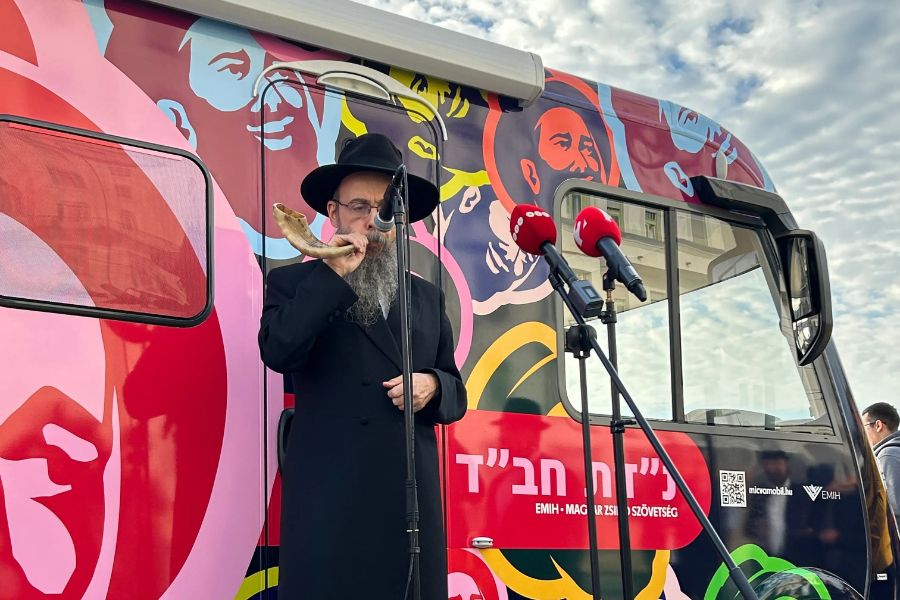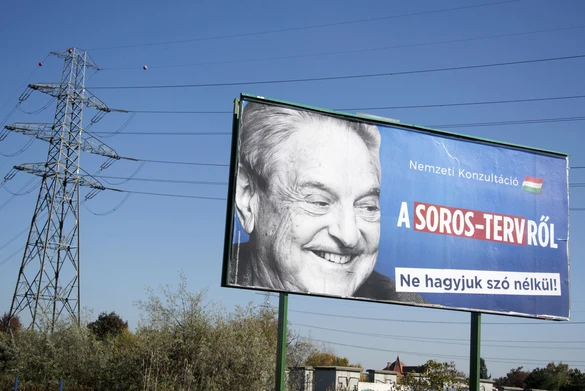V On the bank of the River Danube, next to the memorial for Hungarian victims of the Shoah, a small cluster of Chabadniks gather to inaugurate Europe’s largest Mitzvah Tank.
After a blast of the shofar and a few speeches, the shiny doors of the newly minted van are swung open. Chabad’s new mobile education and outreach hub is launched.
Eighty years after the start of the Hungarian Holocaust, yellow ribbons for the hostages tied onto the iron shoes of the Shoah memorial flicker in the wind as members of the community dance and eat rugelach while tourists squeeze past.
“Today we remember and celebrate at the same time,” Dr Zoltan Furjes, deputy secretary of state for churches and national minorities, tells the crowd.
“We remember everything that happened to Jews and our Jewish compatriots 80 years ago,” the member of Viktor Orbán’s Fidesz Party adds.
Words of clear-cut sympathy – but since the Holocaust the intersection between Jewish life and the Hungarian body politic has been anything but straightforward.
In 2017, Fidesz ran a nationwide advertising campaign vilifying the billionaire financier and Hungarian Holocaust survivor George Soros.
A billboard with a poster of Hungarian-American billionaire and philanthropist George Soros with the lettering “National consultation about the Soros’ plan – Don’t let it pass without any words” is seen in the 22nd district of Budapest on October 16, 2017 (Photo by ATTILA KISBENEDEK / AFP) (Photo by ATTILA KISBENEDEK/AFP via Getty Images)
Furjes told JC: “The campaign against Soros is not about Jewish people. The problem with Soros is not that he is a Jewish man, the problem is what he did and does against Hungary.”
Chabad Rabbi Jonatan Megyeri agreed: “To me, Soros is not even a Jewish man.”
The line used by Fidesz – a strongly ethno-nationalist party – has always been that Soros’s mission is to dilute and compromise Hungarian identity.
The minorities minister said: “Soros wants us to believe we are all the same and like the same things. We [the Fidesz Party] believe in separate countries and separate nations.
“We have to preserve our roots – if we are Hungarian, we have to preserve Hungarians.”
Later, Rabbi Megyeri mused that this was why Orbán befriended Benjamin Netanyahu: “[Israel] is the model of the nation-state and Hungary has a lot to learn from it – far more than the European Union.”
A Jewish local business owner, Edina Schőn, disagreed with the Soros campaign: “They created Soros as the devil, but they didn’t connect him to Judaism. If you knew, then you knew.”
While the financier has been a useful “scapegoat” for the right-wing party, Schőn said, for Hungarian Jews, Soros is irrelevant. For her, the government’s Holocaust narrative was more worrying.
Furjes used his Chabad speech to defend Hungarian actions during what he called “the war of psychosis” – the Second World War – when his country formed an alliance with Hitler’s Germany before thousands of Jews were murdered at the same spot by the Danube and hundreds of thousands were deported to death camps. By the end of the Holocaust, some 565,000 Hungarian Jews had been murdered.
There is no escape from the past in this part of Europe. Inter-generational trauma casts a long shadow, and ghosts lurk around every corner.
Another Jewish community, the Neologs, was the largest of the city’s Jewish groups. Similar to Conservative or Masorti Judaism, the sect is unique to Hungary and was decimated in the war. Páva Street Neolog synagogue was repurposed in 2004 to house the Holocaust Memorial Centre.
Now, the community prays in a sanctuary at the side of the 1920s synagogue, which functions as a museum. They welcomed around 60 people for Rosh Hashanah, sharing the service with another Budapest shul.
The fight over history in Hungary remains a live and ongoing battle.
One sign of that war is the fact that even the Danube Shoah memorial manages to omit Jews – the plaque simply reads: “To the memory of the victims shot into the Danube by Arrow Cross militiamen in 1944-1945”.
A short walk away, a vast monument titled “Memorial for Victims of the German Occupation” was erected in the dead of night in 2014. Ten years on, the shrine, which depicts Hungary as a helpless angel being attacked by an evil eagle symbolising Germany, remains at the centre of an argument over the past.
The Holocaust Educational Trust cited it as an example of “Holocaust distortion”, which suggested that Hungarians were the innocent victims of the Nazis, rather than complicit in the industrial rounding up and deportation of Jews.
“It is disgusting,” said Schőn, who was part of a group of activists who protested against the monument. At the foot of the structure is a collection of Holocaust memorabilia placed by activists, featuring personal objects, photographs and pebbles. The collection, titled a “Living Memorial of Remembrance”, attracts more tourists than the monument that looms behind it.
Chabad, the government’s favoured Jewish organisation, has found itself at the centre of this bitter debate. When Orbán’s government announced plans for a Holocaust museum called the House of Fates, the group was enlisted to help.
Controversial curator Dr Maria Schmidt was selected to oversee the project, writing that museum would tell a “story of love between Hungarian Jews and non-Jews”.
Schmidt is one of Soros’s more vocal critics – she likened him to a “wicked but hugely smart” James Bond villain and accused him of “dismantling national sovereignty”.
Yad Vashem slammed the plan for the museum, saying at the time: “Particularly missing is the role played by Hungarians in the persecution of their Jewish neighbours.”
The museum has since been cancelled because funding ran out, although Chabad said they were keen to develop the project, with or without government support.
The group’s engagement with the Orbán’s party over Holocaust education includes overseeing school textbooks. “We look over everything,” Rabbi Megyeri said.
Still, Orbán is consistently accused of avoiding Hungary’s responsibility for the Holocaust.
High-school pupil and Chabad youth leader Oliver Rak, said: “In general, Hungary takes responsibility for the Holocaust but it is sometimes phrased [in school and by the government] that Germany was more responsible [than Hungary].”
Despite the fight over the past, Rak says Hungarian society today is supportive: “I walk freely with my kippah.” Schőn agreed, “This is a good place to be a Jew.” The government banned pro-Palestine protests and, unlike London, one would struggle to find a Palestinian flag – instead, Hebrew graffiti and buses advertising local Israeli restaurant Mazel Tov are scattered across the city.
The newest Chabad centre includes a synagogue, bagel shop, spa-like mikvah with a nail salon, study rooms, rabbinic office and an enormous soft-play children’s adventure park.
Sparkling mikvahs aside, the group has been accused of extending its influence across the city and using government connections to stage a “hostile takeover” of the Orthodox shul.
When Chabad took the keys to the Kazinczy Street Synagogue, they reportedly locked out Orthodox members without warning, forcing them to daven on the street.
Now the building is being renovated while the Orthodox Jewish Community is appealing against the Chabad-Lubavitch move at the country’s high court.
Rabbi Megyeri denies all allegations of a hostile takeover: “We will not change it [the shul]. We have plenty of synagogues. It is Orthodox Jewry that we don’t want to see disappear. We do not want to see people leaving the community, we are happy to see thriving communities.”
However, the Orthodox community president, Robert Deutsch, and its rabbi, Yankel Eckstein, disagree.
“Chabad have no right to usurp a living community – the whole thing is so shocking and very upsetting,” Rabbi Eckstein said.
Deutsch added: “If Chabad wants to help communities by bringing Jews back to Judaism, why don’t they just help? Why take us over?”
Schőn, who co-owns and runs the Judapest Judaica shop near the shul, said: “Everybody felt sad because Kazinczy was always part of the traditional Hungarian community, not Chabad.” Some have suggested the takeover of Kazinczy could become a source of income for Chabad.
Dohány Street Synagogue down the road attracts more than 500,000 paying visitors annually – Kazinczy might attract some of those tourists.
But Rabbi Megyeri maintains that the group has no plans to change the shul’s purpose: “We do not want to turn it into a Chabad synagogue.”
“Our goal is solely to preserve and operate the historical institutions of the Jewish community in a dignified manner,” Chabad has told the JC.
For Schőn, whose paternal Hungarian Jewish lineage goes back generations, the situation with Chabad is complex.
She appreciates their education programmes, noting her 15-year-old niece has benefited: “She enjoys it so much, she has new friends, she is happy. She could not find anything else.”
But, she says, for a government facing accusations over its treatment of the Holocaust and use of Soros, Chabad remains useful.
“Everybody knows that this government uses Chabad.
“Orbán wants to be clean on the issue of antisemitism. For him, it is important to emphasise that during the war, it was the Nazis, not Hungarians [who committed the genocide].
“Having Jews dressed like Jews on his side is good propaganda,” Schőn said.
A spokesperson for Soros said: “Hungary’s Fidesz government has repeatedly relied on antisemitic tropes to attack George Soros and more recently his son, Alex, notably using ‘puppet master’ imagery that plays to a historic and well-established antisemitic trope, while suggesting that George Soros somehow controls the Hungarian opposition, the European Union, and its political leaders, which is a manifest lie.
“These attacks have been criticised by more progressive Jewish voices in Hungary, as have statements made by political leaders of Prime Minister Orban’s Fidesz in both 2022 and 2023 highlighted in the US State Department’s annual reports on Freedom of Religion.”
The battle over the past – and future – of Jews in Hungary is not over.


![[Missing Credit]](https://www.europesays.com/wp-content/uploads/2024/10/img_9529-jpg.webp)